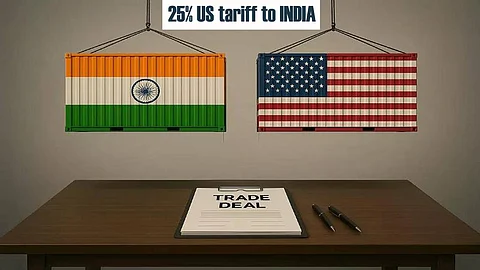

New Delhi | The imposition of a 25 per cent US tariff will not have much impact on India's USD 85 billion worth of exports to America, and New Delhi will not grant any duty exemptions on agriculture items, dairy, and genetically modified (GM) products in the trade pact, sources said on Friday.
About half of the goods exported from India to the US are in the exemption category (such as pharma and electronic goods). So, the impact will be only on the remaining half, according to sources.
"More than half of India's exports to the US will not be impacted by the duty. Due to the Section 232 exemption of the US, only exports worth about USD 40 billion would be impacted with these tariffs," they added.
In 2024-25, the bilateral trade between India and the US stood at USD 131.8 billion (USD 86.5 billion exports and USD 45.3 billion imports).
According to think tank GTRI, the 25 per cent tariffs will not be applicable on the exempted categories, including finished pharmaceutical drugs, active pharmaceutical ingredients (APIs), and other key drug inputs; energy products such as crude oil, refined fuels, natural gas, coal, and electricity; critical minerals; and a wide range of electronics and semiconductors, like computers, tablets, smartphones, solid-state drives, flat panel displays, and integrated circuits.
Sources also said that because of the use of animal feed in the American dairy sector, it would not be possible for India to provide duty concessions on such goods.
India has never given any duty concessions in any of its earlier trade pacts in this sector.
"There are religious sentiments in the dairy sector. So, it is not acceptable. There will be no compromise on these segments (agri, dairy and GM food) in any of India's trade pacts," they said, adding that the remaining exports worth about USD 40 billion will have a little impact on a country with a GDP of about USD 4 trillion and a consumer base of 140 crore.
Commerce and Industry Minister Piyush Goyal on Thursday in Parliament stated that India will take all necessary steps to safeguard and promote national interest.
He has said the government is examining the implications of these tariffs and has engaged with all stakeholders, including exporters and industry, to gather feedback on their assessment of the situation.
India and the US have been negotiating a bilateral trade agreement since March. So far, five rounds of talks have been completed.
The sixth round of talks will be held from August 25.
India's chief negotiator and special secretary in the Department of Commerce Rajesh Agrawal, and Assistant US Trade Representative for South and Central Asia Brendan Lynch held the deliberations.
US President Donald Trump unveiled sweeping new tariffs on dozens of countries, including 25 per cent duties for goods from India, marking a new era of American protectionism that triggered fresh tensions and concerns over a much wider disruption in the global trade landscape.
The US president signed an executive order that raised tariffs for over five dozen countries, with Washington's negotiations for trade deals going down to the wire ahead of the August 1 deadline.
In the Executive Order titled 'Further Modifying The Reciprocal Tariff Rates', Trump announced tariff rates for nearly 70 nations.
With America, India had a trade surplus (the difference between imports and exports) of USD 41 billion in 2024-25. It was USD 35.32 billion in 2023-24 and USD 27.7 billion in 2022-23.
In 2024, India's main exports to the US included drug formulations and biologicals (USD 8.1 billion), telecom instruments (USD 6.5 billion), precious and semi-precious stones (USD 5.3 billion), petroleum products (USD 4.1 billion), vehicle and auto components (USD 2.8 billion), gold and other precious metal jewellery (USD 3.2 billion), ready-made garments of cotton, including accessories (USD 2.8 billion), and products of iron and steel (USD 2.7 billion).
Imports included crude oil (USD 4.5 billion), petroleum products (USD 3.6 billion), coal, coke (USD 3.4 billion), cut and polished diamonds (USD 2.6 billion), electric machinery (USD 1.4 billion), aircraft, spacecraft and parts (USD 1.3 billion), and gold (USD 1.3 billion).
India has already hardened its position on the US demand for duty concessions on agricultural and dairy products. New Delhi has, so far, not given any duty concessions to any of its trading partners in a free trade agreement in the dairy sector.
Certain farmers' associations have urged the government not to include any issues related to agriculture in the trade pact.
India is seeking the removal of this additional tariff. It is also looking at the easing of tariffs on steel and aluminium (50 per cent) and the auto sector (25 per cent). These issues are an important part of the trade pact negotiations.
Against these, India has reserved its right under the WTO (World Trade Organization) norms to impose retaliatory duties.
The country is also seeking duty concessions for labour-intensive sectors, such as textiles, gems and jewellery, leather goods, garments, plastics, chemicals, shrimp, oil seeds, grapes, and bananas, in the proposed trade pact.
On the other hand, the US wants duty concessions on certain industrial goods, automobiles, especially electric vehicles, wines, petrochemical products, agri goods, dairy items, apples, tree nuts, and genetically modified crops.
The two countries are looking to conclude talks for the first tranche of the proposed bilateral trade agreement (BTA) by fall (October-November) this year.
India's merchandise exports to the US rose 22.8 per cent to USD 25.51 billion in the April-June quarter this financial year, while imports rose 11.68 per cent to USD 12.86 billion.
